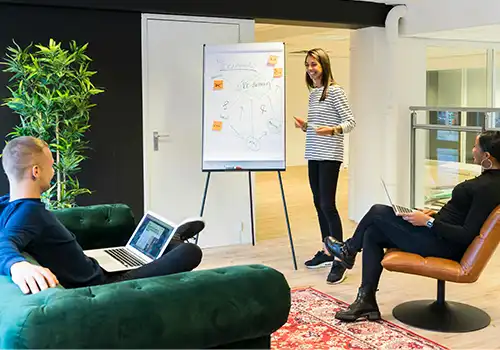Robotics
Course In Vellore
Master the fundamentals of modern robotics in just 3–6 months with our Robotics Course in Vellore. You’ll learn robot types and workspaces, Arduino and embedded systems, Python scripting for sensor I/O, motion control with PID, CAD design in SolidWorks/TinkerCAD, PLC programming, and ROS-based simulation in Gazebo/RViz. Hands-on labs and a capstone project will take you from circuit diagrams to a demo-ready robotic system, preparing you for roles in automation and robotics engineering.
Course Request Form
Robotics Course Duration
3 to 6 months
Foundations of Robotics
- Types of robots: mobile, arms, AGVS, cobots
- Degrees of Freedom (DOF) & workspace
- Real-World applications in industries
Arduino and Embedded Systems
- Digital/Analog I/O and PWM control
- Sensor Interfacing: IR, Ultrasonic, Temperature
- Motor control: DC, Servo and Stepper
Python for Robotics
- IPython syntax, Loops, Functions
- Reading sensor data and logging
- Interfacing with Raspberry Pi GPIO
Motion Control and Actuators
- Motor drivers and H-Bridge circuits
- Proximity sensors & encoders
- Closed-loop control and PID tuning
CAD & Mechanical Design
- Robot structure: links, joints and chassis
- Design in SolidWorks/TinkerCAD
- Basic motion simulation
Industrial Automation
- PLC and ladder logic programming
- Timers, counters, safety interlocks
- SCADA and HMI interface basics
Robotics Simulation and ROS
- ROS basics: nodes, topics and publishers
- Mobile robot simulation in Gazebo
- Visualizing data in RViz
Learning Outcomes and Capstone Projects
- Build and program a complete robotic system
- Design circuit diagrams, write code, and test plans
- Present a demo-ready project for portfolio/showcase
- Be job-ready for roles in robotics and automation
Live Industry Project
As part of our Robotics Course in Vellore, you’ll collaborate on a real-world automation project guided by industry mentors.
*Duration One to Two Hours*

Answers to Your Queries
Frequently Asked Questions
Who should enroll in this program?
Anyone interested in robotics, from beginners to engineering students, can benefit from our Robotics Course in Vellore.
What hardware and software do I need?
You’ll need an Arduino board (e.g., Uno), sensors (IR, ultrasonic, temperature), motors (DC, servo, stepper) and drivers, a Raspberry Pi for GPIO projects, CAD software (SolidWorks or TinkerCAD), and a PC set up with ROS, Gazebo, and Python.
Which programming languages and tools will I master?
You’ll code in C/C++ (Arduino), Python (sensor logging, Raspberry Pi), Ladder Logic (PLC), and work with SolidWorks/TinkerCAD, ROS, Gazebo, and RViz for simulation and visualization.
What major projects will I complete?
“Projects in our Robotics Course in Vellore range from Arduino-based automation to ROS-driven simulations.
Is embedded systems training part of this program?
Yes, you will work with Arduino and Raspberry Pi to learn digital and analog I/O, PWM control, interfacing various sensors like IR, ultrasonic, and temperature sensors, and controlling different motors.
What kind of final project can I expect to complete?
You will complete a demo-ready robotics project that showcases your ability to design, build, program, and present a functional robotic system, which you can include in your portfolio.
Looking for something else? Click here for our detailed FAQs page
Your Feedback Matters
Google Review
Very dissatisfied with this business. They never return calls or emails, and they totally disregard messages from customers. Very unprofessional — I would strongly advise avoiding them if this is how they handle clients.
The session when the trainer conducted is efficient and easy to understand. Exploring the datasets with the algorithm.The friendly trainer guidence and clear the doubts related to the content.
I like to learn many things in python it was easy to forget me now.
Thank for teaching me about this python.
Thank sooo much mam
experience I your institution.
1. ROBOTICS INTERNSHIP in vellore, JOY INNOVATION.
2. I Learned about the the robotics and application.
3. The experience is so good for me. Because of i love my physics. I learn basic circuits like connection on breadboard, led, diode, resister, transistor, UNO, ARDUINO.
4. JOY INNOVATION delivers both theoretical understanding and practical experience through hands-on training, real-world projects, and interactive workshop.
5. I learn about the various types of sensor i is help full to me for my final year project.
THANKYOU 😊
The institute provides an excellent platform for students to gain hands-on experience in robotics and embedded systems. The internship program is well-structured, practical, and guided by experienced mentors. The learning environment is innovative, encouraging creativity and real-world problem-solving. A great place for students to grow technically and professionally. The institute offers a dynamic and engaging environment for learning robotics. Their internship program is highly practical, with real-time projects that boost technical skills and confidence. With supportive mentors and a focus on innovation, it's an ideal place for students to explore and grow in the field of robotics and technology.




















